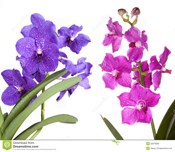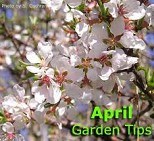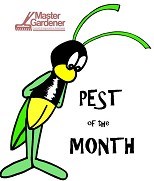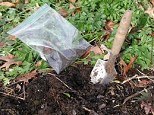The largest family of flowering plants is the orchid family (Orchidaceae), which has around 28,000 species. Prized by collectors for their beautiful blooms, and threatened by habitat loss, many orchids are now endangered in the wild. New methods of propagation, including tissue culture, have made some orchid species such as Moth Orchids more affordable. The key to growing your orchid successfully is to know which species it is.
All orchids need a balance of light, air, water and food to grow and flower well. Most orchids grow best in bright, indirect light. Place the orchid close to an east, west, or lightly shaded south window. Avoid direct sunlight as the leaves burn easily. If your orchid will not bloom it probably needs more light.
Most tropical orchids are epiphytes, which means that they grow in the air, rather than in soil. These orchids require more air around their roots than terrestrial plants. For this reason orchid potting media should have large particles with plenty of pore space, have exceptionally good drainage, but still be capable of holding sufficient moisture to support the plant.
Incorrect watering or keeping the roots too wet is the main culprit for orchids dying. Wet roots lead to rotted roots. Most orchids should be watered just as they start to dry out. Check the medium with your finger, and if you feel any moisture, do not water. Plastic pots hold moisture longer than clay. Plants should be watered until it runs freely from the drainage holes. Not only does this soak the potting medium but it also flushes salts that accumulate in the growing medium. Orchids are sensitive to salts so try to thoroughly water your plants at least once a month.
What about watering with ice cubes? It seems counterintuitive to put ice on the roots of a tropical plant. The Oregon Orchid Society does not recommend this method. They prefer the drenching method which also helps provide the humidity that orchids need. If you experiment using ice cubes, do not let the ice directly touch the roots or any part of the plant, as this will damage the cells and can lead to other problems.
Orchids will grow and flower for fairly long periods without fertilizer, but you will get better results with some level of feeding. The American Orchid Society recommends applying a dilute (one-quarter strength) fertilizer each time plants are watered, rather than applying a full dose once a month. Feed “weakly, weekly.” It is best not to fertilize a completely dry plant as fertilizer can burn the dry roots. Orchids will do better with too little fertilizer than too much. Typically plants are fertilized once a week during the summer and every two weeks in the fall and winter. As orchid growth slows in the winter cut down on the amount of fertilizer. Look for fertilizers that contain little or no urea. This is because soil organisms must convert the nitrogen in urea to a useable form. Since orchids do not grow in soil, this conversion does not occur efficiently.
The Phalaenopsis (fail-eh-NOP-sis) or moth orchid is one of the easiest to grow at home and it is widely available. They grow under similar conditions as African violets. Phalaenopsis is derived from the Greek and means moth-like. The flat flowers on gently arching stems resemble moths in flight. The flowers last three months or more which is one reason for their popularity.
Moth orchid blooms come in a variety of shapes, sizes and colors, most often delicate pastel shades. All have the same growth habit, which is three to five or more flat, fleshy leaves, with one or two flowering stems growing from between them. Each stem can hold six to over a dozen beautiful blooms. The blossom size and number of flowers per stem vary by variety.
In their native, tropical Asian habitat, moth orchids are epiphytes. They grow attached to tree branches in diffused light, so place it in an area that receives bright, indirect light. Their abundant roots are white or silvery. The roots often grow outside the pot, which is normal. They grow best with the humidity at 50 percent or higher.
Phalaenopsis grow well when temperatures are in the range of 60 to 85 degrees F. Check the temperature at the window sill during the winter. Do not let temperatures drop below 60 degrees F or this will harm the plant. In the fall, allow the night temperature to drop down to 60 degrees F for three weeks as this will help induce a flower spike. The flower spike should start to grow about three weeks after the cold treatment.
Moth orchids typically flower once a year but the season of bloom varies by species or hybrid. To identify a new bloom spike, look for roots that are growing upwards with glossy green points, rather than round tips. The flower spike will grow in the direction of the greatest light source. Once the flower spike starts growing, do not turn the plant around. If you do, the spike will continue growing toward the window and you will end up with a crooked flower spike. Once a bloom spike appears, increase fertilizing to every other week with a liquid houseplant fertilizer that has been diluted to half the recommended strength.
After the flowers drop off you can either leave the flower spike, cut it back to a node, or remove it. If you leave the stem new blooms may emerge from the tip. Cutting the stem back to the second or third node might prompt the plant to produce a new flower spike where you made the cut. You can also remove the spent flower spike by cutting it off at the base of the plant. If the stem starts to turn brown or yellow cut it off as a withered stem will not produce new blooms.
If you want to learn more about orchids and how to care for them, Longwood Gardens is offering a free online course. Check out their website at https://longwoodgardens.org/.
Beautiful and exotic orchids make a lovely addition to your home decor.
———
Have a garden question? Contact the Cornell Cooperative Extension Fulton & Montgomery Counties Master Gardeners for assistance. They may be reached by calling (518) 853-2135.
Jan Beglinger is the agriculture outreach coordinator for Cornell Cooperative Extension.





